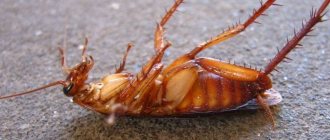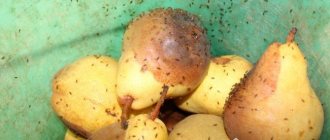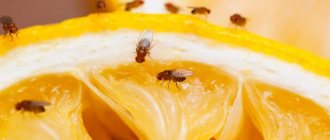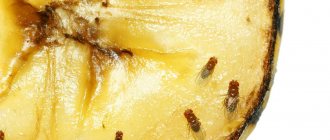The fruit fly is a small, harmless insect, but it is always unpleasant to find one in the house. She is attracted by the smell of spoiled fruits and nectar in the flowers of indoor plants. In the warm season, Drosophila can fly into a living room from the street if you simply spray an air freshener with a berry or fruit scent in the room. How to get rid of fruit flies in an apartment? What products should you use?
Where do fruit flies come from in the house?
There are several ways for a fly to enter an apartment:
- The insect chooses soft, slightly or severely spoiled fruits as a place for laying eggs, since their peel is easier to bite through. Since both the fly itself and its eggs are small in size, it is almost impossible to notice that a vegetable or fruit is infected.
- Fly larvae and eggs can appear in the house along with soil for indoor plants.
- Open windows without mosquito nets or open doors are another way for an insect to get into the apartment. Midges fly to the smell of fruits, indoor flowers or spoiled food.
Features of flies
Flies are arthropod insects from the order of flies and mosquitoes. In nature, there are a sufficient number of species of flies that differ in size: there are flies several millimeters in size, as well as several centimeters. The fly lives for about two months, but during this time it is capable of laying a large number of eggs and causing harm to human health, of course, under certain conditions.
Flies are distinguished by the fact that they have huge eyes consisting of several thousand hexagonal lenses. Thanks to its eyes, the fly sees everything that happens around it. That's why she's so hard to catch. Houseflies live exclusively in human homes and are almost impossible to find in nature. Flies often appear in apartments in summer and autumn. During these periods there is simply no end to them. They behave quite arrogantly and can spoil the mood of anyone.
The housefly's body is brown in color, with brown tints. On top of the head are large eyes and short antennae. The fly is armed with wings and three pairs of legs. The housefly grows up to 8 mm in length, while the males are somewhat smaller in size. The legs have suction cups, which allows the fly to be securely held on any surface, including smooth ones.
The fly has an excellent sense of smell. She can smell food from a great distance. The fly does not disdain anything, but prefers food products in liquid form, including spoiled ones. The fly feeds with the help of a long proboscis, through which food is absorbed in liquid form. The fly first dissolves solid food with its saliva and then sucks it through its proboscis.
Where to look for fruit fly larvae in an apartment?
To get rid of these small insects, it is not enough to simply destroy the adult individuals - fruit flies reproduce actively, the female is capable of laying about 20 eggs at a time, and in 2 months (this is the lifespan of an adult insect) she can produce up to 2000 eggs. Insects hatch in the early morning, and already 8 hours after this, the female is ready to reproduce. If you do not start fighting Drosophila in time, it will easily fill the entire house.
The most common habitats of midges:
- A trash can or a bowl of food for a pet is where optimal conditions are created for the laying of eggs and the accumulation of adult insects, because there is no shortage of food in such a place.
- Pots with indoor flowers. Wet soil and fallen leaves that are beginning to rot are also attractive to insects.
- Storage areas for vegetables and fruits. If there are several fruits in a container, one of them may begin to deteriorate before the others, and flies will definitely smell it.
Main types of pests
Midges in the country are an unpleasant fact that cannot be predicted in advance. You never know which pest will be a bothersome guest in your garden beds this coming summer.
White midges (whitefly)
Midges on cucumbers and other crops can appear both in the garden and in the greenhouse, and sometimes even manage to end up right in the house.
The whitefly feeds on plant sap, which causes their death. In addition, it secretes a special substance, which, settling on the leaves, leads to the formation of the so-called sooty fungus, which interferes with normal air exchange and photosynthesis. Plants become covered with a sticky crust, turn black and die.
Whiteflies are often carriers of a variety of diseases, which they transmit to healthy plants.
Whitefly
Black midges (melon aphid)
This insect is one of the most dangerous pests in gardens, affecting cucumbers and other crops.
On plants affected by aphids, the leaves curl and dry out. The processes of photosynthesis and nutrient formation slow down. The fruits ripen much more slowly. Aphids can cause complete crop loss. In addition, it is also a carrier of viral diseases.
melon aphid
Mining flies
Mining flies, or miners, are small insects 2-3 mm long. When starting to lay eggs, the female pierces the leaf membrane with the sharp end of her ovipositor and lays eggs in soft tissue. 5 days later, the eggs hatch into larvae. They intensively gnaw plant tissue, making numerous passages in them, which are called mines. Hence the name - miners.
After two weeks, the larva pupates, having first moved to the ground and burrowed into it. After some time, an adult fly emerges from the pupa.
These midges pose a danger to many garden crops, often introducing themselves into them at the seedling stage. Punctures made by the miner and passages gnawed by the larvae violate the integrity of the leaves. The pest eats away the soft tissue of the leaves and drinks the sap of the plant, as a result of which the plant gradually dies.
Mining front sight
Cabbage fly
The cabbage fly threatens not only cabbage, but also other vegetable crops. The flight of midges coincides with the timing of planting cabbage in the ground. After a few days, mating occurs. The midge lays up to 150 eggs in small groups at the roots of cabbage, as well as in the soil near the plant.
The greatest damage is caused by the first generation cabbage fly larvae. Early cabbage varieties suffer the most from midges. The first sign of the presence of cabbage fly larvae in cabbage roots is stunted growth and wilted leaves. The larvae damage the root from the inside, which leads to disruption of the supply of nutrients to the above-ground part of the plant.
Cabbage fly
How to deal with fruit fly?
Having noticed the appearance of uninvited guests in the house, you need to carefully inspect the apartment and find all the spoiled food: fruit forgotten on the table, sour leftover food in the trash can, pet food in a bowl that has spoiled in the heat. If tea leaves are used as a fertilizer for indoor flowers, you also need to inspect the pots with soil.
All detected possible sources of Drosophila must be disposed of immediately by sending them to the trash. Containers for storing fruits and vegetables should be thoroughly washed to remove larvae and eggs invisible to the eye from the surfaces.
Flowers need to be transplanted into pots with fresh soil. If some of the leaves or flowers of the plant begin to rot, they are removed. The indoor plants themselves are watered often, but little by little - waterlogged soil attracts midges.
Traditional methods
To clear your apartment of midges, you can build your own traps:
- Since one of the Drosophila's favorite treats is banana, it can be used as bait. Peel the fruit and place it in a plastic bag or plastic bottle. Using a toothpick, make several holes in polyethylene or plastic. Leave the trap near the midge habitat. Over the next 2 days, a significant portion of the midges will fly inside, but they will not be able to get out.
- Just as much as bananas, the fruit fly Drosophila loves honey, fruit juice or apple cider vinegar. The trap is made like this: take a deep container, pour one of the listed liquids into it, and cover it with a bag or cling film. Make holes with a toothpick. Insects attracted by the smell will climb into the trap.
- Another possible option is to use a glass jar. A piece of banana, orange or any spoiled fruit is placed at the bottom. A cone is made from a sheet of paper with a small hole at the top. Turning it over, insert the blank into the neck of the bottle. The midges will easily get inside the jar, but they will not be able to fly back out.
- Beer, water diluted with sugar and yeast are poured into a disposable glass and left close to the accumulation of insects. Hearing a tempting smell, the midges will fly towards it and drown.
In addition to traps, you can use other means.
Smoking
The crushed hard camphor is placed in an old frying pan (one that you don’t mind throwing away) and put on fire. As soon as the frying pan is hot and steam starts to flow, the container is carried throughout all rooms of the apartment. The resulting smoke is not dangerous for humans, but midges will not tolerate it.
Poison for midges
A couple of recipes for poisonous treats for insects:
- ½ cup of milk is mixed with 40 g of sugar and the same amount of ground black pepper. Soak a paper napkin or a piece of toilet paper in the liquid and place it on a plate next to the midges. After a while there will be no insects left.
- 10 g of honey is combined with 1 g of saccharin, and a napkin is moistened with this mixture. Place it on the windowsill.
Vacuum cleaner
The place where midges have accumulated is treated with a vacuum cleaner. A running unit will draw in insects, trapping them in a dust bag. The container must be emptied outside the apartment.
Cold
Drosophila are very sensitive to temperature; hypothermia is detrimental to them. If they attacked the apartment in winter, it is enough to simply leave the window in the kitchen open when leaving the house. After a few hours, all the flies will die.
This way you can destroy adult insects, but if there are larvae left somewhere, then after a while the insects will appear again. To prevent this from happening, it is recommended to thoroughly wash the pet’s trash can and bowl, and water the soil in flower pots with a manganese solution.
Potassium permanganate or matches
This method is suitable if there are flies on the plant. Prepare a weak solution of manganese and treat flowers with it twice a month.
You can also use regular matches: stick them head down into the ground in the pot. The sulfur from the match will destroy the larvae.
Geranium
Fruit flies cannot tolerate the smell of geraniums. If there are midges in the kitchen, you need to get rid of the spoiled fruit and place a pot with this plant on the windowsill of the room.
Garlic
Midges do not like the smell of garlic, so placing the crushed head near the Drosophila habitat helps. After a few hours there will be no insects.
Orange and clove
A stick of spice is stuck into the orange peel and placed next to the place where midges gather.
Store products
How to get rid of fruit flies if you don’t have time to bother with building traps or preparing poisonous compounds? You can use ready-made traps or preparations.
Manufacturers offer a choice of:
- Repellents. Tapes impregnated with chemical compounds, from which vapors that poison insects emanate. Such products cannot be called completely safe for humans - the room in which the tape is located must be ventilated.
- Sprays. Special liquids containing fatty acids, falling on larvae and insects, destroy them. They are not dangerous to humans.
- Zappers. Modern devices that affect insects with electricity. The only drawback of some models is their high power consumption.
- Traps. Factory-made traps do not contain poison; most of them use a substance that attracts insects, and the midge that flies into the trap dies of hunger, unable to get out. You can even install such devices in the kitchen without fear that they will harm a person or animal.
How to remove fruit flies using traditional methods
A good remedy against these insects is ordinary table vinegar. To do this, all cabinets and shelves for storing food are washed with soapy water. Then all surfaces are wiped with a solution of table vinegar. Additionally, strong-smelling substances are placed in areas where fruit flies accumulate. Garlic cloves, orange peels, and lavender leaves are suitable for this.
Camphor aroma works well against fruit flies. Camphor is crushed into pieces and fried in a dry frying pan. When smoke starts, remove the container from the heat and carry it through all the rooms. In rooms where flies accumulate more than other rooms, it is worth staying longer. Camphor is not dangerous for people and animals. Therefore, there is no need to remove anyone from the apartment before such treatment.
Preventive measures
It’s not difficult to prevent the appearance of fruit flies in your apartment; all you need to do is:
- keep clean;
- regularly (at least once a day) take out the bucket;
- wash dishes immediately after a meal;
- Throw away spoiled fruits immediately;
- Do not leave food in your pet’s bowl for a long time, remove it as soon as the animal eats.
If the midges have nothing to eat, they will not appear in the apartment.
Even if midges have infested your apartment, you should not immediately rush to the store for chemicals - you can get rid of them using traditional methods, without the use of toxic substances.
Prevention
To prevent annoying neighbors from appearing in your home, you need to take preventive measures in advance.
They are very simple and effective:
- Flowers are transplanted into pots with fresh soil.
- Watering is carried out moderately.
- The soil for planting is pre-calcined in the oven.
- Decayed flowers and leaves are immediately removed.
- Fruits and dairy products are not stored in the public domain. They should only be kept in the refrigerator.
- Housing must be cleaned regularly.
- The kitchen trash can should be emptied daily. After the garbage is thrown out, the bucket must be washed and disinfected.
- Do not leave food in pet bowls. After eating, the dishes of dogs and cats are washed thoroughly.
- Rotten fruits and vegetables are thrown away.
- Periodically turn on a mosquito lamp or keep an ultrasonic insect trap in the house.
- The kitchen sink is filled with boiling water and products such as Mole or Domestos.
- The fumigator is turned on periodically to repel insects.
- All household utensils are washed immediately after cooking and eating, and work surfaces in the kitchen are thoroughly wiped down.
- Avoid dampness in the bathroom. Wet and dirty laundry is not left behind.
- The windows are covered with a fine-mesh insect net.
- Spontaneous garbage dumps and compost pits are not installed near the house.
- Ensures regular garbage removal.











